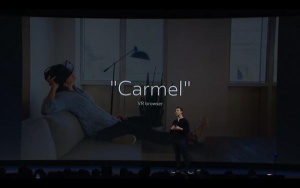Carmel
Carmel is a virtual reality (VR) web browser developed by Oculus VR. It was revealed in October 2016, during the company’s annual developer conference Oculus Connect 3. Since December, a Developer Preview version of Carmel is available in the Gallery Apps section for Gear VR. It is designed for developers looking to create VR experiences viewed through the browser using the WebVR API (an API that provides headsets access to web-based VR content). The Developer Preview contains several samples that showcase what can be done with VR on the web. It also contains documentation to aid the developers to make their own content. The company says that Carmel is “optimized for performance, designed for navigation and input in VR, and will be tightly integrated with Home and run on any Oculus device.” [1] [2] [3].
When it came out, the VR browser was still in an early stage of development, not even having an address bar. Currently, the focus is mainly on the possibilities of VR web browsing, but the plan is for Carmel to allow access to both traditional 2D content and VR experiences through the web. There is also available the Carmel Starter Kit, for download or viewable online (provided the user has a compatible browser). Its goal is to teach developers how to get their content running inside a headset, how to utilize the Gear VR’s touchpad on the web, how to navigate HTML5 in VR, and display 360-degree content on a web page. Oculus’ dedicated WebVR page has examples of what is possible to do with the API. Carmel is based on a version of WebVR that the major browser vendors believe can reach general availability in 2017. Oculus VR is working alongside their partners at Google, Microsoft, and Mozilla to deliver VR browsing, a key milestone for the Web [1].
Nate Mitchell, Oculus co-founder, stated that the WebVR initiative “is going to lead to an exponential growth in VR content out there. Everyone in the future is going to have their own VR destination on the web.” [2] [4] During the Oculus Connect 3 conference, Mitchell presented some examples of VR content for prospective developers. One of them was a web-based photo sphere site that he said could be completed in a few days. Another one was an interactive 3D rendering of a new car [2] [4].
With Carmel, Oculus improves one of its platform´s disadvantages: the inability of its users to go online through the brand’s app. The browser will have support for Oculus Rift in the future [3]. Oculus has also announced React VR, which is a VR-focused version of the React open source javascript library created by Facebook. Its goal is to help developers build VR web content [2] [4].
References
- ↑ 1.0 1.1 Feltham, J. (2016). Oculus launches developer preview of its WebVR browser, ‘Carmel’, on Gear VR. Retrieved from https://uploadvr.com/carmel-launches-developer-preview-gear/
- ↑ 2.0 2.1 2.2 2.3 Hayden, S. (2016). Oculus to support WebVR through new VR browser codenamed ‘Carmel’. Retrieved from http://www.roadtovr.com/oculus-support-webvr-new-vr-browser-codenamed-carmel/
- ↑ 3.0 3.1 Ivoylova, A. (2016). Oculus Carmel Developer Preview browser has appeared in the Gear VR store. Retrieved from http://en.holographica.space/news/oculus-carmel-developer-preview-browser-appeared-gear-vr-store-6663
- ↑ 4.0 4.1 4.2 Weber, H. (2016). Oculus teases the VR Web, Carmel VR browser, and React VR. Retrieved from https://venturebeat.com/2016/10/06/oculus-teases-the-vr-web-carmel-vr-browser-and-react-vr/
